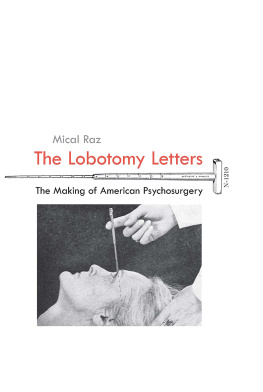Mental Health in Historical Perspective
Series Editors
Catharine Coleborne
School of Humanities and Social Science, University of Newcastle, Callaghan, NSW, Australia
Matthew Smith
Centre for the Social History of Health and Healthcare, University of Strathclyde, Glasgow, UK
Covering all historical periods and geographical contexts, the series explores how mental illness has been understood, experienced, diagnosed, treated and contested. It will publish works that engage actively with contemporary debates related to mental health and, as such, will be of interest not only to historians, but also mental health professionals, patients and policy makers. With its focus on mental health, rather than just psychiatry, the series will endeavour to provide more patient-centred histories. Although this has long been an aim of health historians, it has not been realised, and this series aims to change that.
The scope of the series is kept as broad as possible to attract good quality proposals about all aspects of the history of mental health from all periods. The series emphasises interdisciplinary approaches to the field of study, and encourages short titles, longer works, collections, and titles which stretch the boundaries of academic publishing in new ways.
More information about this series at http://www.palgrave.com/gp/series/14806
Jesper Vaczy Kragh
Lobotomy Nation
The History of Psychosurgery and Psychiatry in Denmark
1st ed. 2021

Logo of the publisher
Jesper Vaczy Kragh
Centre for Health Research in the Humanities, University of Copenhagen, Copenhagen, Denmark
ISSN 2634-6036 e-ISSN 2634-6044
Mental Health in Historical Perspective
ISBN 978-3-030-65305-7 e-ISBN 978-3-030-65306-4
https://doi.org/10.1007/978-3-030-65306-4
The Editor(s) (if applicable) and The Author(s), under exclusive license to Springer Nature Switzerland AG 2021
This work is subject to copyright. All rights are solely and exclusively licensed by the Publisher, whether the whole or part of the material is concerned, specifically the rights of translation, reprinting, reuse of illustrations, recitation, broadcasting, reproduction on microfilms or in any other physical way, and transmission or information storage and retrieval, electronic adaptation, computer software, or by similar or dissimilar methodology now known or hereafter developed.
The use of general descriptive names, registered names, trademarks, service marks, etc. in this publication does not imply, even in the absence of a specific statement, that such names are exempt from the relevant protective laws and regulations and therefore free for general use.
The publisher, the authors and the editors are safe to assume that the advice and information in this book are believed to be true and accurate at the date of publication. Neither the publisher nor the authors or the editors give a warranty, expressed or implied, with respect to the material contained herein or for any errors or omissions that may have been made. The publisher remains neutral with regard to jurisdictional claims in published maps and institutional affiliations.
Cover image: Lennart Nilsson/TT Nyhetsbyrn
This Palgrave Macmillan imprint is published by the registered company Springer Nature Switzerland AG
The registered company address is: Gewerbestrasse 11, 6330 Cham, Switzerland
Preface
This book tells the story of one of medicines most (in)famous treatments: the neurosurgical operation commonly known as lobotomy. The book itself is the serendipitous result of a series of more or less random events that occurred some years ago, at a time when I knew nothing about high-risk neurosurgical practices on psychiatric patients. Back then, I was studying a group of Danes who claimed to commune with the deadthe spiritualists from the twentieth centuryand the history of psychiatry was unknown territory to me. Nevertheless, I made my way, via a somewhat circuitous route, from spiritualism to psychiatry. It turned out that early-twentieth-century psychiatrists had taken a keen interest in the spiritualists conversations with the dead. In order to gain insight into the link between the two groups, I started searching for information about the evolution of psychiatry. It was not easy to find. The history of psychiatry in Denmark has only been sparingly and sporadically recorded. I decided it was worthy of closer study, and I was fortunate enough to secure funding for a research project in 2002. To this day, my interest in psychiatry has remained undiminished.
In the course of my research, I was particularly drawn to the somatic treatments in psychiatry. In the early twentieth century, Danish psychiatrists all seemed to agree on the use of therapies like Cardiazol shock, insulin coma therapy, electroshock and lobotomy on patients admitted to the big mental hospitals. Accounts ranged from miraculous healing to severely adverse side-effects, from sky-high recovery rates to zero effect.
The popularity of the last of these physical treatments, lobotomy, came as a particular surprise to me. A picture started to emerge of a Danish lobotomy tradition. In fact, evidence suggests that more lobotomies were performed in Denmark than any other country, an unofficial world record that I was surprised to find had failed to make its way into the history books. Indeed, even in works on the history of Danish medicine, there was not one word about the thousands of people who had undergone this surgical procedure to their prefrontal lobes. Why the silence? Why did Danish psychiatrists so enthusiastically embrace this method? Lobotomy became the focal point of the project, and the question of its widespread use in Denmark became the starting point for my studies.
In search of potential explanations for the widespread use of lobotomy, I turned to the international literature on the subject but discovered no unambiguous answers. In fact, I found only a few in-depth studies, and even the most illustrious works offered explanations that pointed in different directions. As a consequence, I started to relate the Danish example to theories in international research and follow other paths not covered in the literature.
One such path led me to contemporary perspectives on methods of physical treatment in twentieth-century psychiatry. For many Danish psychiatrists, somatic treatmentsnot just lobotomy, but also electroshock and othersrepresented a turning point in the history of their discipline. The intriguing idea that these kinds of treatments, which would be so harshly criticised by posterity, were revolutionary for so many psychiatrists opened up for other questions: How did lobotomy and other somatic therapies fit into the bigger picture of the way both psychiatry and society were developing in the early twentieth century?
This book is the result of those studies. The story begins in 1922 and ends in 1983at least, in so far as it can be said to end at all. The debate about lobotomy rumbles on, and to this day, psychosurgery is still a topic of debate in many parts of the world. In the recent past, neurosurgeons and psychiatrists have stressed that this new form of surgery is a rapidly evolving discipline, and plans to reintroduce psychosurgery have been on the agenda in several countriesincluding Denmark. The most recent innovation is Deep Brain Stimulation, which has created high expectations in many circles. This, on the other hand, has encouraged other researchers to express concern about repeating the mistakes of the past. My book represents a contribution to that discussion.









